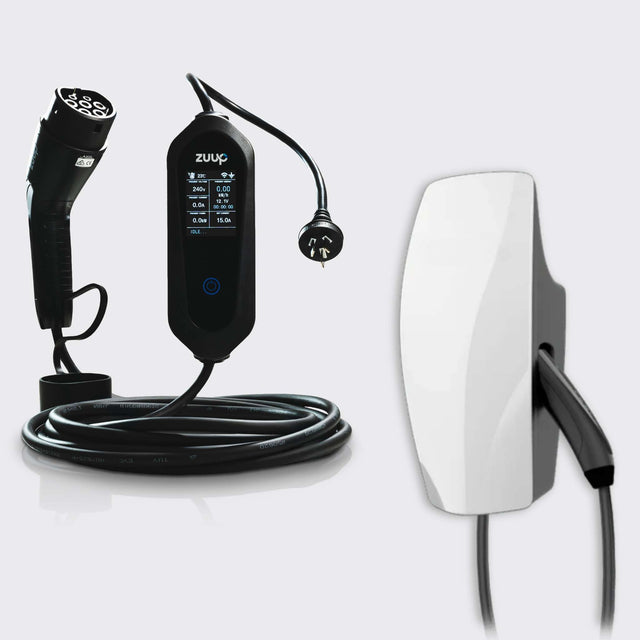Do you really need a fixed wall charger?
Intro - The home charging myth
A lot of Aussie EV owners think they need a fixed wall charger at home. But here’s the thing - most of you probably don’t. And if you’ve been led to believe that installing a wall-mounted charger is the only way to get a proper home charging setup, you’ve had the wool pulled over your eyes.
Let’s step back for a minute – understanding home power points
Before we dive further, let’s quickly break down the different types of power points you’ll find in Aussie homes:
-
10A Standard Power Outlet: The regular household socket. It delivers about 2.4kW of charging power, which is pretty slow - around 10-12km of range per hour.
-
15A Power Outlet: Found in some garages and workshops, it looks just like the 10A standard power outlet but with a bigger Earth socket - this outlet delivers 3.5kW of charging power, giving you around 20km of range per hour.
-
32A Single-Phase Power Outlet: The sweet spot for most home EV owners. It delivers 7kW of charging power, or about 40km of range per hour, making it ideal for overnight charging.
-
Three-Phase Power Outlet: Less common in homes but great for fast home charging. A 22kW setup can add 120km of range per hour, but most EVs won’t even charge that fast at home.
|
Power Outlet Type |
Charging Power |
Range Added Per Hour |
Notes |
|
10A Standard Power Outlet |
2.2kW |
12km |
Common in households, slowest charging option. |
|
15A Power Outlet |
3.5kW |
20km |
Found in some garages / workshops, has a larger Earth socket. |
|
32A Single-Phase Power Outlet |
7kW |
40km+ |
Ideal for overnight charging, recommended for most home setups. |
|
Three-Phase Power Outlet |
Up to 22kW |
Up to 120km |
Great for faster home charging, but not all EVs can utilise full capacity. |
The smarter, more flexible alternative? A portable 7kW charger + a 32A outlet
Let’s break it down. If you install a 32A single-phase outlet (which should not cost you more than $400 including install - speaking from experience!) and pair it with a zuup Charge Flex 7kW portable charger, you get all the benefits of a fixed charger - without the unnecessary cost or limitations.
-
Charging Speed: 7kW charging delivers around 40km of range per hour. Plug in at night, wake up to a full battery. Job done.
-
Cost Comparison: A fixed wall charger installation can set you back $1,500+. Meanwhile, a 32A outlet + portable charger setup costs significantly less while giving you more flexibility.
-
Flexibility Advantage: A wall charger is stuck to your garage wall, whereas a portable charger goes wherever you do - road trips, holiday homes, even work. It’s the ultimate ‘take it anywhere’ solution.
But what about 15A power outlets?
A lot of garages already have a 15A outlet (which gives you around 3.5kW of charging power, or roughly 20km of range per hour). If that works for your driving habits, you don’t even need to upgrade to a 32A outlet.
However, if you don’t have a 15A outlet or you need a faster charge, that’s where installing a 32A outlet comes in handy. It’s a one-time install that sets you up for life - without the extra cost of a fixed charger.
The real-world experience
When I installed mine, I had both a 15A outlet and 32A industrial power outlet installed. The cost? $400 all up, including an additional relay in the switchboard for the 32A outlet.
For a more general guide on power outlet installation costs, check out this post on hipages: How much does it cost to install a Powerpoint?. They say a standard install runs between $150-$300, but for 32A outlets, it may require extra work depending on your switchboard setup.
The best home charging setup? zuup Charge Flex + 32A outlet
For the price of a fixed charger install, you could get a zuup Charge Flex AND a 32A power outlet, and still have change left over. Plus, you’re not locked into one spot - you get a charger that can travel with you.
When is a fixed wall charger worth it?
There are some cases where a fixed wall charger makes sense:
-
High Daily Kilometres: If you’re regularly driving over 300km per day and need faster charging speeds, a three-phase wall charger might be a better option.
-
Multi-Vehicle Households: If multiple EVs in your home need to charge simultaneously, a fixed setup with load balancing might help manage energy use.
-
Long-Term Property Investment: If you’re future-proofing your home and want a permanently mounted charging solution, a wall charger might be worth considering.
TL;DR
You probably don’t need a fixed wall charger. A zuup Charge Flex + 32A outlet is the smarter, more cost-effective setup for most Aussie EV drivers. But if you’re a high-kms driver or managing multiple EVs, a fixed charger could make sense.
My suggestion: Save your cash, go portable.
-
Get quotes from Tradies on hipages, quick smart!
Charge on, legends! ✌️
Author: James Kleine | zuup Founder / EV enthusiast (and petrol-head at heart).
